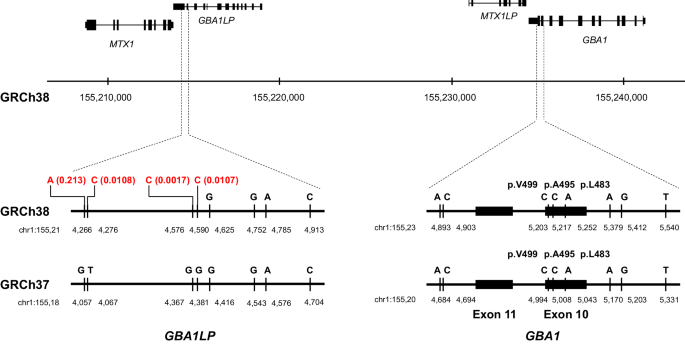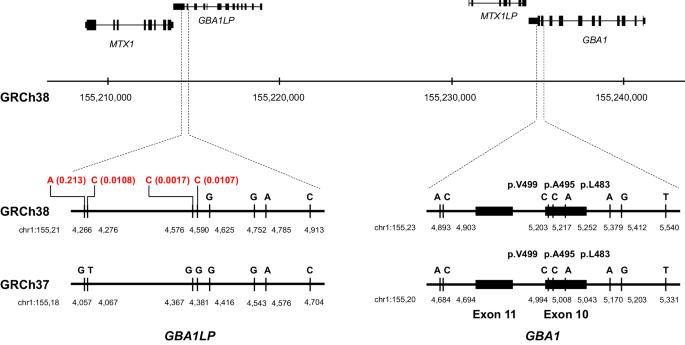基于综合序列分析的 GBA1 变异与 MSA 的关联研究--取决于人类参考基因组的短读序列分析的陷阱。
IF 2.6
3区 生物学
Q2 GENETICS & HEREDITY
引用次数: 0
摘要
多系统萎缩症(MSA)是一种神经退行性疾病,其特征是自主神经功能衰竭、帕金森病和小脑共济失调的各种组合。为了阐明与 MSA 相关的变异,我们一直在进行基于短读数的全基因组序列分析。在关联研究的过程中,我们最初关注的是 GBA1,这是之前提出的 MSA 易感基因,目的是评估尽管 GBA1 与其假基因 GBA1LP 有着极高的同源性,但是否仍能有效地鉴定出 GBA1 变异。为此,我们进行了与 GRCh38 比对的短线程全基因组序列分析以及 Sanger 序列分析,并对结果进行了比较。我们在两个管道中发现了五个不一致的变异,其中三个变异(p.L483P、p.A495P-p.V499V、p.L483_M489delinsW)是由于在 GRCh38 中登记的 GBA1P1 中的小等位基因造成的错误比对结果。这些变异中的错配事件通过与作为参考基因组的 GRCh37 进行比对得到了解决,因为在 GRCh37 中登记了主要等位基因。此外,通过短读或 Sanger 序列分析,一个结构变异没有被正确识别。在完成正确的变异调用后,我们确定了三个戈谢病致病变异(p.S310G、p.L483P 和 p.L483_M489delinsW)。在这些变异中,p.L483P 在 MSA 病例中的等位基因频率(0.003)高于对照组(0.0011)。荟萃分析表明,p.L483P 与 MSA 有显著关联,其几率为 2.92(95% CI;1.08 - 7.90,p = 0.0353)。本文章由计算机程序翻译,如有差异,请以英文原文为准。


Association study of GBA1 variants with MSA based on comprehensive sequence analysis -Pitfalls in short-read sequence analysis depending on the human reference genome-
Multiple system atrophy (MSA) is a neurodegenerative disorder characterized by various combinations of autonomic failure, parkinsonism, and cerebellar ataxia. To elucidate variants associated with MSA, we have been conducting short-read-based whole-genome sequence analysis. In the process of the association studies, we initially focused on GBA1, a previously proposed susceptibility gene for MSA, to evaluate whether GBA1 variants can be efficiently identified despite its extraordinarily high homology with its pseudogene, GBA1LP. To accomplish this, we conducted a short-read whole-genome sequence analysis with alignment to GRCh38 as well as Sanger sequence analysis and compared the results. We identified five variants with inconsistencies between the two pipelines, of which three variants (p.L483P, p.A495P–p.V499V, p.L483_M489delinsW) were the results of misalignment due to minor alleles in GBA1P1 registered in GRCh38. The miscalling events in these variants were resolved by alignment to GRCh37 as the reference genome, where the major alleles are registered. In addition, a structural variant was not properly identified either by short-read or by Sanger sequence analyses. Having accomplished correct variant calling, we identified three variants pathogenic for Gaucher disease (p.S310G, p.L483P, and p.L483_M489delinsW). Of these variants, the allele frequency of p.L483P (0.003) in the MSA cases was higher than that (0.0011) in controls. The meta-analysis incorporating a previous report demonstrated a significant association of p.L483P with MSA with an odds ratio of 2.85 (95% CI; 1.05 – 7.76, p = 0.0400).
求助全文
通过发布文献求助,成功后即可免费获取论文全文。
去求助
来源期刊

Journal of Human Genetics
生物-遗传学
CiteScore
7.20
自引率
0.00%
发文量
101
审稿时长
4-8 weeks
期刊介绍:
The Journal of Human Genetics is an international journal publishing articles on human genetics, including medical genetics and human genome analysis. It covers all aspects of human genetics, including molecular genetics, clinical genetics, behavioral genetics, immunogenetics, pharmacogenomics, population genetics, functional genomics, epigenetics, genetic counseling and gene therapy.
Articles on the following areas are especially welcome: genetic factors of monogenic and complex disorders, genome-wide association studies, genetic epidemiology, cancer genetics, personal genomics, genotype-phenotype relationships and genome diversity.
 求助内容:
求助内容: 应助结果提醒方式:
应助结果提醒方式:


